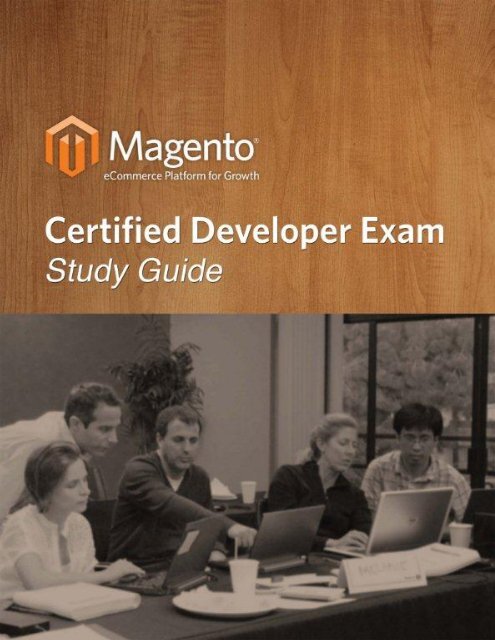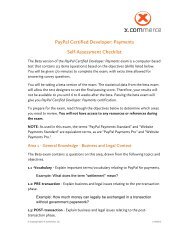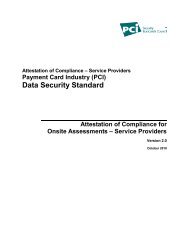Magento® Certified Developer Exam Study Guide
Magento® Certified Developer Exam Study Guide
Magento® Certified Developer Exam Study Guide
Create successful ePaper yourself
Turn your PDF publications into a flip-book with our unique Google optimized e-Paper software.
© Copyright 2013 X.commerce, Inc. All rights reserved. 01-01-13
Magento ® <strong>Certified</strong> <strong>Developer</strong> <strong>Exam</strong> <strong>Study</strong> <strong>Guide</strong> page<br />
Table of Contents<br />
Introduction .......................................................................................................................................... 3<br />
1- Basics ................................................................................................................................................. 4<br />
2- Request Flow .................................................................................................................................... 7<br />
3- Rendering ......................................................................................................................................... 11<br />
4- Working with Database in Magento ........................................................................................... 18<br />
5- Entity-Attribute-Value (EAV) Model ............................................................................................ 20<br />
6- Adminhtml ...................................................................................................................................... 23<br />
7- Catalog ............................................................................................................................................ 28<br />
8- Checkout ........................................................................................................................................ 32<br />
9- Sales and Customers ..................................................................................................................... 36<br />
10- Advanced features ....................................................................................................................... 39<br />
Sample Questions .............................................................................................................................. 41<br />
Answers to Sample Questions .......................................................................................................... 43<br />
© 2013 X.commerce, Inc. version 2.2 January 2013<br />
1
Magento ® <strong>Certified</strong> <strong>Developer</strong> <strong>Exam</strong> <strong>Study</strong> <strong>Guide</strong> page<br />
© 2013 X.commerce, Inc. version 2.2 January 2013<br />
2
Magento ® <strong>Certified</strong> <strong>Developer</strong> <strong>Exam</strong> <strong>Study</strong> <strong>Guide</strong> page<br />
Introduction<br />
This <strong>Study</strong> <strong>Guide</strong> is intended to help you prepare for the <strong>Magento®</strong> <strong>Certified</strong> <strong>Developer</strong> <strong>Exam</strong>.<br />
For each content area of the exam, the <strong>Study</strong> <strong>Guide</strong> details the objectives (skills) that are<br />
tested by the exam. For each objective, it provides questions that you should ask yourself as<br />
you study the Magento code base, along with code references that you can use as entry points<br />
to find answers to those questions.<br />
This <strong>Study</strong> <strong>Guide</strong> is continually being revised and improved. When preparing for the exam,<br />
remember to check the website for the latest version of this <strong>Study</strong> <strong>Guide</strong>.<br />
© 2013 X.commerce, Inc. version 1.2 January 2013<br />
3
Magento ® <strong>Certified</strong> <strong>Developer</strong> <strong>Exam</strong> <strong>Study</strong> <strong>Guide</strong> page<br />
1- Basics<br />
This topic comprises approximately 6% of the Standard form of the exam. Questions are<br />
drawn randomly from the following topics and objectives:<br />
High-level Magento architecture<br />
○ Describe Magento codepools<br />
○ Describe typical Magento module structure<br />
○ Describe Magento templates and layout files location<br />
○ Describe Magento skin and JavaScript files location<br />
○ Identify and explain the main Magento design areas (adminhtml and frontend)<br />
○ Explain class naming conventions and their relationship with the autoloader<br />
○ Describe methods for resolving module conflicts.<br />
To verify your understanding of these objectives, ask yourself the following<br />
questions:<br />
■ How does the framework interact with the various codepools?<br />
■ What constitutes a namespace and a module?<br />
■ What does the structure of a complete theme look like?<br />
These code references can be used as an entry point to find answers to the questions<br />
above:<br />
Magento configuration<br />
■ Mage_Core_Model_App<br />
■ Mage_Core_Model_Config<br />
■ Varien_Autoload<br />
○ Explain how Magento loads and manipulates configuration information<br />
○ Describe class group configuration and use in factory methods<br />
○ Describe the process and configuration of class overrides in Magento<br />
○ Register an Observer<br />
© 2013 X.commerce, Inc. version 1.2 January 2013<br />
4
Magento ® <strong>Certified</strong> <strong>Developer</strong> <strong>Exam</strong> <strong>Study</strong> <strong>Guide</strong> page<br />
○ Identify the function and proper use of automatically available events, including<br />
*_load_after, etc.<br />
○ Set up a cron job<br />
Since Magento is an XML DOM configuration-based framework, a thorough<br />
understanding of how Magento loads and assembles its configuration XML DOM is a<br />
core competency.<br />
■ How does the framework discover active modules and their<br />
configuration?<br />
■ What are the common methods with which the framework accesses its<br />
configuration values and areas?<br />
■ How are per-store configuration values established in the XML DOM?<br />
■ By what process do the factory methods and autoloader enable class<br />
instantiation?<br />
■ Which class types have configured prefixes, and how does this relate to<br />
class overrides?<br />
■ Which class types and files have explicit paths?<br />
■ What configuration parameters are available for event observers?<br />
■ What are the interface and configuration options for automatically fired<br />
events?<br />
■ What is the structure of event observers, and how are properties<br />
accessed therein?<br />
■ What configuration parameters are available for cron jobs?<br />
These code references can be used as an entry point to find answers to the questions<br />
above:<br />
Internationalization<br />
■ Mage_Core_Model_App_Area<br />
■ Mage_Core_Model_Config<br />
■ Mage_Core_Model_Store<br />
■ Varien_Event_Observer<br />
○ Describe how to plan for internationalization of a Magento site<br />
○ Describe the use of Magento translate classes and translate files<br />
○ Describe the advantages and disadvantages of using subdomains and subdirectories<br />
in internationalization<br />
© 2013 X.commerce, Inc. version 1.2 January 2013<br />
5
Magento ® <strong>Certified</strong> <strong>Developer</strong> <strong>Exam</strong> <strong>Study</strong> <strong>Guide</strong> page<br />
To verify your understanding of these objectives, ask yourself the following<br />
questions:<br />
■ Which method is used for translating strings, and on which types of<br />
objects is it generally available?<br />
■ In what way does the developer mode influence how Magento handles<br />
translations?<br />
■ How many options exist to add a custom translation for any given<br />
string?<br />
■ What is the priority of translation options?<br />
■ How are translation conflicts (when two modules translate the same<br />
string) processed by Magento?<br />
These code references can be used as an entry point to find answers to the questions<br />
above:<br />
■ Mage_Core_Model_Translate::init()<br />
■ Mage_Core_Model_Locale::emulate()<br />
© 2013 X.commerce, Inc. version 1.2 January 2013<br />
6
Magento ® <strong>Certified</strong> <strong>Developer</strong> <strong>Exam</strong> <strong>Study</strong> <strong>Guide</strong> page<br />
2- Request Flow<br />
This topic comprises approximately 7% of the exam. Questions are drawn randomly from the<br />
following topics and objectives:<br />
Application initialization<br />
○ Describe the steps for application initialization<br />
○ Describe the role of the system entrypoint, index.php<br />
Starting with the index.php, including Mage.php, follow through the steps<br />
Magento takes to set up the run time environment.<br />
■ How and when is the include path set up and the auto loader registered?<br />
■ How and when does Magento load the base configuration, the module<br />
configuration, and the database configuration?<br />
■ How and when are the two main types of setup script executed?<br />
■ When does Magento decide which store view to use, and when is the<br />
current locale set?<br />
■ Which ways exist in Magento to specify the current store view?<br />
■ When are the request and response objects initialized?<br />
These code references can be used as an entry point to find answers to the questions<br />
above:<br />
Front Controller<br />
■ index.php<br />
■ Mage_Core_Model_App::run()<br />
■ Mage_Core_Model_Config::loadBase() and init()<br />
○ Describe the role of the front controller<br />
○ Identify uses for events fired in the front controller<br />
Follow the flow of control through front controller initialization until an action<br />
controller is dispatched.<br />
■ Which ways exist in Magento to add router classes?<br />
■ What are the differences between the various ways to add routers?<br />
■ Think of possible uses for each of the events fired in the front controller<br />
© 2013 X.commerce, Inc. version 1.2 January 2013<br />
7
Magento ® <strong>Certified</strong> <strong>Developer</strong> <strong>Exam</strong> <strong>Study</strong> <strong>Guide</strong> page<br />
URL rewrites<br />
These code references can be used as an entry point to find answers to the questions<br />
above:<br />
■ Mage_Core_Controller_Varien_Front::init() and<br />
dispatch()<br />
○ Describe URL structure/processing in Magento<br />
○ Describe the URL rewrite process<br />
Focus on the internals of database-based URL rewrites.<br />
■ What is the purpose of each of the fields in the core_url_rewrite<br />
table?<br />
■ When does Magento created the rewrite records for categories and<br />
products?<br />
■ How and where does Magento find a matching record for the current<br />
request?<br />
These code references can be used as an entry point to find answers to the questions<br />
above:<br />
Request routing<br />
■ Mage_Core_Controller_Varien_Front::dispatch()<br />
■ Mage_Core_Model_Url_Rewrite::rewrite()<br />
○ Describe request routing/request flow in Magento<br />
○ Describe how Magento determines which controller to use and how to customize<br />
route-to-controller resolution<br />
Starting with the front controller delegating the process of mapping a request to a<br />
controller action, study the steps that occur until a controller action is dispatched.<br />
■ Which routers exist in a native Magento implementation?<br />
■ How does the standard router map a request to a controller class?<br />
■ How does the standard router build the filesystem path to a file that<br />
might contain a matching action controller?<br />
■ How does Magento process requests that cannot be mapped?<br />
■ After a matching action controller is found, what steps occur before the<br />
action method is executed?<br />
© 2013 X.commerce, Inc. version 1.2 January 2013<br />
8
Magento ® <strong>Certified</strong> <strong>Developer</strong> <strong>Exam</strong> <strong>Study</strong> <strong>Guide</strong> page<br />
These code references can be used as an entry point to find answers to the questions<br />
above:<br />
Module initialization<br />
■ Mage_Core_Controller_Varien_Front::init()<br />
■ Mage_Core_Controller_Varien_Router_Standard::coll<br />
ectRoutes() and match()<br />
○ Describe the steps needed to create and register a new module<br />
○ Describe the effect of module dependencies<br />
○ Describe different types of configuration files and the priorities of their loading<br />
This objective covers how Magento loads modules and how modules interact with<br />
each other.<br />
■ What does "Magento loads modules" mean?<br />
■ In which order are Magento modules loaded?<br />
■ Which core class loads modules?<br />
■ What are the consequences of one module depending on another<br />
module?<br />
■ During the initialization of Magento, when are modules loaded in?<br />
■ Why is the load order important?<br />
■ What is the difference regarding module loading between<br />
Mage::run() and Mage::app()?<br />
These code references can be used as an entry point to find answers to the questions<br />
above:<br />
■ Mage::run() and Mage::app()<br />
■ Mage_Core_Model_App::run() and init()<br />
Design and layout initialization<br />
○ Identify the steps in the request flow in which:<br />
– Design data is populated<br />
– Layout configuration files are parsed<br />
– Layout is compiled<br />
– Output is rendered<br />
© 2013 X.commerce, Inc. version 1.2 January 2013<br />
9
Magento ® <strong>Certified</strong> <strong>Developer</strong> <strong>Exam</strong> <strong>Study</strong> <strong>Guide</strong> page 10<br />
The design configuration is part of Magento's view implementation. This objective<br />
covers the processing of these XML instructions.<br />
■ Which ways exist to specify the layout update handles that will be<br />
processed during a request?<br />
■ Which classes are responsible for the layout being loaded?<br />
■ How are layout xml directives processed?<br />
■ Which configuration adds a file containing layout xml updates to a<br />
module?<br />
■ Why is the load order of layout xml files important?<br />
These code references can be used as an entry point to find answers to the questions<br />
above:<br />
Flushing data (output)<br />
■ Mage_Core_Controller_Varien_Action::loadLayout()<br />
■ Mage_Core_Model_Layout::__construct()<br />
■ Mage_Core_Model_Layout_Update::load()<br />
○ Describe how and when Magento renders content to the browser<br />
○ Describe how and when Magento flushes output variables using the Front controller<br />
This objective covers the response object as well as combining JavaScript and CSS<br />
files.<br />
■ Which events are associated with sending output?<br />
■ Which class is responsible for sending output?<br />
■ What are possible issues when this output is not sent to the browser<br />
using the typical output mechanism, but is instead sent to the browser<br />
directly?<br />
■ How are redirects handled?<br />
These code references can be used as an entry point to find answers to the questions<br />
above:<br />
■ Mage_Core_Controller_Varien_Front::dispatch()<br />
■ Mage_Core_Controller_Response_Http and super<br />
classes<br />
■ Mage_Page_Block_Html_Head::getCssJsHtml()<br />
© 2013 X.commerce, Inc. version 1.2 January 2013
Magento ® <strong>Certified</strong> <strong>Developer</strong> <strong>Exam</strong> <strong>Study</strong> <strong>Guide</strong> page 11<br />
3- Rendering<br />
This topic comprises approximately 7% of the exam. Questions are drawn randomly from the<br />
following topics and objectives:<br />
Themes in Magento<br />
○ Define and describe the use of themes in Magento:<br />
■ How you can use themes to customize core functionality?<br />
■ How can you implement different designs for different stores using<br />
Magento themes?<br />
■ In which two ways you can register custom theme?<br />
These code references can be used as an entry point to find answers to the questions<br />
above:<br />
■ Mage_Core_Model_Layout<br />
■ Mage_Core_Model_Layout_Update<br />
■ Mage_Core_Model_Design<br />
■ Mage_Core_Model_Design_Package<br />
○ Define and describe the use of design packages:<br />
■ What is the difference between package and theme?<br />
■ What happens if the requested file is missed in your theme/package?<br />
These code references can be used as an entry point to find answers to the questions<br />
above:<br />
■ Mage_Core_Model_Layout<br />
■ Mage_Core_Model_Layout_Update<br />
■ Mage_Core_Model_Design<br />
■ Mage_Core_Model_Design_Package<br />
Mage_Core_Block_Template<br />
○ Describe the process of defining template file paths:<br />
■ Which kind of paths (absolute or relative) does Magento use for<br />
templates and layout files?<br />
■ How exactly can Magento define which physical file correspond to<br />
certain template/layout to use?<br />
■ Which classes and methods need to be rewritten in order to add<br />
additional directories to the fallback list?<br />
© 2013 X.commerce, Inc. version 1.2 January 2013
Magento ® <strong>Certified</strong> <strong>Developer</strong> <strong>Exam</strong> <strong>Study</strong> <strong>Guide</strong> page 12<br />
Blocks<br />
These code references can be used as an entry point to find answers to the questions<br />
above:<br />
■ Mage_Core_Model_Design<br />
■ Mage_Core_Model_Design_Package<br />
■ Mage_Core_Block_Template<br />
○ Describe the programmatic structure of blocks:<br />
■ What are blocks used for in Magento?<br />
■ What is the parent block for all Magento blocks?<br />
■ Which class does each block that uses a template extend?<br />
■ In which way does a template block store information about its<br />
template file? Does it store an absolute or a relative path to the<br />
template?<br />
■ What is the role of the Mage_Core_Block_Abstract class?<br />
These code references can be used as an entry point to find answers to the questions<br />
above:<br />
■ Mage_Core_Model_Layout<br />
■ Mage_Core_Model_Layout_Update<br />
■ Mage_Core_Block_Template<br />
■ Mage_Core_Block_Abstract<br />
■ Mage_Adminhtml_Block_Abstract<br />
○ Describe the relationship between templates and blocks:<br />
■ Can any block in Magento use a template file?<br />
■ How does the $this variable work inside the template file?<br />
■ Is it possible to render a template without a block in Magento?<br />
■ Is it possible to have a block without a template in Magento?<br />
These code references can be used as an entry point to find answers to the questions<br />
above:<br />
■ Mage_Core_Block_Template<br />
■ Mage_Core_Block_Abstract<br />
○ Describe the stages in the lifecycle of a block:<br />
■ Which class is responsible for creating an instance of the block?<br />
■ Which class is responsible for figuring out which blocks should be<br />
created for certain pages?<br />
© 2013 X.commerce, Inc. version 1.2 January 2013
Magento ® <strong>Certified</strong> <strong>Developer</strong> <strong>Exam</strong> <strong>Study</strong> <strong>Guide</strong> page 13<br />
■ How is the tree of blocks typically rendered?<br />
■ Is it possible to create an instance of the block and render it on the page<br />
without using the Magento layout?<br />
■ Is it possible to create an instance of the block and add it to the current<br />
layout manually?<br />
■ How are a block’s children rendered? Once you added a child to the<br />
block, can you expect it will be rendered automatically?<br />
■ What is a difference in rendering process for different types of blocks?<br />
These code references can be used as an entry point to find answers to the questions<br />
above:<br />
■ Mage_Core_Model_Layout<br />
■ Mage_Core_Model_Layout_Update<br />
■ Mage_Core_Block_Template<br />
■ Mage_Core_Block_Abstract<br />
■ Mage_Core_Block_Text<br />
■ Mage_Core_Block_Text_List<br />
○ Describe events fired in blocks:<br />
■ How can block output be caught using an observer?<br />
■ What events do Mage_Core_Block_Abstract and<br />
Mage_Core_Block_Template fire?<br />
These code references can be used as an entry point to find answers to the questions<br />
above:<br />
■ Mage_Core_Block_Abstract<br />
○ Identify different types of blocks:<br />
■ What is the purpose of each of the following block types:<br />
− Mage_Core_Block_Template<br />
− Mage_Core_Block_Text_List<br />
− Mage_Core_Block_Text<br />
■ Which block type renders its children automatically?<br />
■ Which block type is usually used for a “content” block on Magento<br />
pages?<br />
These code references can be used as an entry point to find answers to the questions<br />
above:<br />
■ Mage/Core/Block/*<br />
■ Mage_Core_Block_Abstract<br />
© 2013 X.commerce, Inc. version 1.2 January 2013
Magento ® <strong>Certified</strong> <strong>Developer</strong> <strong>Exam</strong> <strong>Study</strong> <strong>Guide</strong> page 14<br />
■ Mage_Core_Block_Template<br />
■ Mage_Core_Block_Text<br />
■ Mage_Core_Block_Text_List<br />
■ Mage_Page_Block_Html_Head<br />
○ Describe block instantiation:<br />
■ How can a template’s block instance be accessed inside the template<br />
file, and how can other block instances be accessed?<br />
■ How can block instances be accessed from the controller?<br />
■ How can block instances be accessed inside install scripts or other<br />
model class instances?<br />
These code references can be used as an entry point to find answers to the questions<br />
above:<br />
■ Mage_Core_Model_Layout<br />
■ Mage_Core_Model_Layout_Update<br />
■ Mage_Core_Controller_Varien_Action<br />
○ Explain different mechanisms for disabling block output:<br />
■ In which ways can block output be disabled in Magento?<br />
■ Which method can be overridden to control block output?<br />
These code references can be used as an entry point to find answers to the questions<br />
above:<br />
■ Mage_Core_Model_Layout<br />
○ Describe how a typical block is rendered:<br />
■ Which class performs rendering of the template?<br />
■ Which classes are responsible for figuring out the absolute path for<br />
including the template file?<br />
■ In which method are templates rendered?<br />
■ How can output buffering be enabled/disabled when templates are<br />
rendered?<br />
These code references can be used as an entry point to find answers to the questions<br />
above:<br />
■ Mage_Core_Model_Layout<br />
■ Mage_Core_Model_Layout_Update<br />
■ Mage_Core_Block_Template<br />
■ Mage_Core_Block_Abstract<br />
© 2013 X.commerce, Inc. version 1.2 January 2013
Magento ® <strong>Certified</strong> <strong>Developer</strong> <strong>Exam</strong> <strong>Study</strong> <strong>Guide</strong> page 15<br />
Design layout, XML schema, and CMS content directives<br />
○ Describe the elements of Magento's layout XML schema, including the major layout<br />
directives:<br />
■ How are , , and used in<br />
Magento layout?<br />
■ Which classes and methods determine which nodes from layout XML<br />
correspond to certain URLs?<br />
These code references can be used as an entry point to find answers to the questions<br />
above:<br />
■ Mage_Core_Model_Layout<br />
■ Mage_Core_Model_Layout_Update<br />
■ Mage_Core_Block_Abstract<br />
○ Register layout XML files:<br />
■ How can layout XML files be registered for the frontend and adminhtml<br />
areas?<br />
These code references can be used as an entry point to find answers to the questions<br />
above:<br />
■ Mage_Core_Model_Layout_Update<br />
○ Create and add code to pages:<br />
■ How can code be modified or added to Magento pages using the<br />
following methods?<br />
− Template customizations<br />
− Layout customizations<br />
− Overriding block classes<br />
− Registering observers on general block events<br />
■ In which circumstances are each of the above methods more or less<br />
appropriate than others?<br />
These code references can be used as an entry point to find answers to the questions<br />
above:<br />
■ Mage_Core_Controller_Varien_Action<br />
■ Mage/Core/Block/*<br />
■ Mage_Core_Block_Abstract<br />
■ Mage_Core_Block_Template<br />
© 2013 X.commerce, Inc. version 1.2 January 2013
Magento ® <strong>Certified</strong> <strong>Developer</strong> <strong>Exam</strong> <strong>Study</strong> <strong>Guide</strong> page 16<br />
■ Mage_Core_Block_Text<br />
■ Mage_Core_Block_Text_List<br />
■ Mage_Page_Block_Html_Head<br />
○ Explain how variables can be passed to block instances via layout XML:<br />
■ How can variables be passed to the block using the following methods?<br />
− From layout xml file<br />
− From controller<br />
− From one block to another<br />
− From an arbitrary location (for example, install/upgrade scripts,<br />
models)<br />
■ In which circumstances are each of the above methods more or less<br />
appropriate than others?<br />
These code references can be used as an entry point to find answers to the questions<br />
above:<br />
■ Mage_Core_Model_Layout<br />
■ Mage_Core_Controller_Varien_Action<br />
■ Mage/Core/Block/*<br />
■ Mage_Core_Block_Abstract<br />
■ Mage_Core_Block_Template<br />
■ Mage_Core_Block_Text<br />
■ Mage_Core_Block_Text_List<br />
■ Mage_Page_Block_Html_Head<br />
○ Describe various ways to add and customize JavaScript to specific request scopes:<br />
■ Which block is responsible for rendering JavaScript in Magento?<br />
■ Which modes of including JavaScript does Magento support?<br />
■ Which classes and files should be checked if a link to a custom JavaScript<br />
file isn’t being rendered on a page?<br />
These code references can be used as an entry point to find answers to the questions<br />
above:<br />
■ Mage/Core/Block/*<br />
■ Mage_Core_Block_Abstract<br />
■ Mage_Core_Block_Template<br />
■ Mage_Core_Block_Text<br />
■ Mage_Core_Block_Text_List<br />
■ Mage_Page_Block_Html_Head<br />
© 2013 X.commerce, Inc. version 1.2 January 2013
Magento ® <strong>Certified</strong> <strong>Developer</strong> <strong>Exam</strong> <strong>Study</strong> <strong>Guide</strong> page 17<br />
General References for this section:<br />
Mage_Core_Model_Layout<br />
Mage_Core_Model_Layout_Update<br />
Mage_Core_Model_Design<br />
Mage_Core_Model_Design_Package<br />
Mage_Core_Controller_Varien_Action<br />
© 2013 X.commerce, Inc. version 1.2 January 2013
Magento ® <strong>Certified</strong> <strong>Developer</strong> <strong>Exam</strong> <strong>Study</strong> <strong>Guide</strong> page 18<br />
4- Working with Databases in Magento<br />
This topic comprises approximately 13% of the exam. Questions are drawn randomly from the<br />
following topics and objectives:<br />
Models, resource models, and collections<br />
○ Describe the basic concepts of models, resource models, and collections, and the<br />
relationship they have to one another<br />
○ Configure a database connection<br />
○ Describe how Magento works with database tables<br />
○ Describe the load-and-save process for a regular entity<br />
○ Describe group save operations<br />
○ Describe the role of Zend_Db_Select in Magento<br />
○ Describe the collection interface (filtering/sorting/grouping)<br />
○ Describe the hierarchy of database-related classes in Magento<br />
○ Describe the role and hierarchy of setup objects in Magento<br />
These objectives fall into two broad areas. The first is about how models work with<br />
resource models and collections in order to access the database storage layer; the<br />
second is about how to work with the database directly by using the adapter classes<br />
and the Zend_Db_Select object to create queries.<br />
■ Which methods exist to access the table of a resource model?<br />
■ Which methods exist to create joins between tables on collections and<br />
on select instances?<br />
■ How does Magento support different RDBMSs?<br />
■ How do table name lookups work, and what is the purpose of making<br />
table names configurable?<br />
■ Which events are fired automatically during CRUD operations?<br />
■ How does Magento figure out if a save() call needs to create an<br />
INSERT or an UPDATE query?<br />
■ How many ways exist to specify filters on a flat table collection?<br />
■ Which methods exist to influence the ordering of the result set for flat<br />
table collections? How do the methods differ?<br />
© 2013 X.commerce, Inc. version 1.2 January 2013
Magento ® <strong>Certified</strong> <strong>Developer</strong> <strong>Exam</strong> <strong>Study</strong> <strong>Guide</strong> page 19<br />
■ Why and how does Magento differentiate between setup, read, and<br />
write database resources?<br />
These code references can be used as an entry point to find answers to the questions<br />
above:<br />
Install/upgrade scripts<br />
■ Mage_Core_Model_Abstract<br />
■ Mage_Core_Model_Resource_Db_Abstract<br />
■ Mage_Core_Model_Resource_Db_Collection_Abstract<br />
■ Mage_Core_Model_Resource::getTableName()<br />
■ Zend_Db_Select<br />
○ Describe the install/upgrade workflow<br />
○ Write install and upgrade scripts using set-up resources<br />
○ Identify how to use the DDL class in setup scripts<br />
Each module can encapsulate the preparation and upgrade of the database table it<br />
requires via setup scripts.<br />
■ Under which circumstances are setup scripts executed?<br />
■ What is the difference between the different classes used to execute<br />
setup scripts?<br />
■ Which is the base setup class for flat table entities, and which one the<br />
base for EAV entities?<br />
■ Which methods are generally available in setup scripts to manipulate<br />
database tables and indexes?<br />
■ What is the difference between addAttribute() and<br />
updateAttribute() in EAV setup scripts?<br />
■ How can you implement a rollback in Magento?<br />
These code references can be used as an entry point to find answers to the questions<br />
above:<br />
■ Mage_Core_Model_App::run() and _initModules()<br />
■ Mage_Core_Model_Resource_Setup::applyAllUpdates()<br />
and applyAllDataUpdates()<br />
■ Mage_Eav_Model_Entity_Setup::addAttribute() and<br />
updateAttribute()<br />
© 2013 X.commerce, Inc. version 1.2 January 2013
Magento ® <strong>Certified</strong> <strong>Developer</strong> <strong>Exam</strong> <strong>Study</strong> <strong>Guide</strong> page 20<br />
5- Entity-Attribute-Value (EAV) Model<br />
This topic comprises approximately 10% of the exam. Questions are drawn randomly from the<br />
following topics and objectives:<br />
EAV model concepts<br />
○ Define basic EAV concepts and class hierarchy<br />
○ Describe the database schema for EAV entities<br />
○ Describe the EAV entity structure and its difference from the standard core resource<br />
model<br />
○ Describe the EAV load-and-save process and its differences from the regular loadand-save<br />
process<br />
This objective covers understanding how EAV entity values are stored in the<br />
database, how the involved tables relate, how the EAV resource models differ from<br />
the flat table resource models and how the EAV models process CRUD operations.<br />
■ Which classes in Mage_Eav are used as resource models and which are<br />
used as regular models?<br />
■ How do flat and EAV resource models differ?<br />
■ Which entities in a native Magento installation use EAV resource models<br />
and why?<br />
■ What are the advantages and disadvantages of EAV over flat table<br />
resource models?<br />
■ How are store and website scope attribute values implemented in the<br />
Magneto EAV system?<br />
■ How does the model distinguish between insert and update operations?<br />
■ How do load and save processes for EAV entities differ from those for<br />
flat table entities? What parts are identical?<br />
These code references can be used as an entry point to find answers to the questions<br />
above:<br />
■ Mage_Eav_Model_Config<br />
■ Mage_Eav_Model_Entity_Abstract<br />
■ Mage_Eav_Model_Entity_Collection_Abstract<br />
■ Mage_Eav_Model_Entity_Abstract::load() and save()<br />
■ Mage_Core_Model_Abstract::load() and save()<br />
■ Mage_Eav_Model_Entity_Collection_Abstract::load()<br />
© 2013 X.commerce, Inc. version 1.2 January 2013
Magento ® <strong>Certified</strong> <strong>Developer</strong> <strong>Exam</strong> <strong>Study</strong> <strong>Guide</strong> page 21<br />
Attributes management<br />
■ Mage_Core_Model_Resource_Db_Collection_Abstract::<br />
load()<br />
○ Identify the purpose of attribute frontend, source, and backend models<br />
○ Describe how to implement the interface of attribute frontend, source, and backend<br />
models:<br />
■ How do attribute models, attribute source models, attribute backend<br />
models and attribute frontend models relate to each other?<br />
■ Which methods have to be implemented in a custom source model (or<br />
frontend model or backend model)?<br />
■ Can adminhtml system configuration source models also be used for<br />
EAV attributes?<br />
■ What is the default frontend model (and source and backend model) for<br />
EAV attributes?<br />
■ Does every attribute use a source model?<br />
■ Which classes and methods are related to updating the EAV attribute<br />
values in the flat catalog tables? What factors allow for attributes to be<br />
added to flat catalog tables?<br />
■ How are store-scoped entity attribute values stored when catalog flat<br />
storage is enabled for that entity type?<br />
■ Which frontend, source, and backend models are available in a stock<br />
Magento installation?<br />
■ How do multi-lingual options for attributes work in Magento?<br />
■ How do you get a list of all options for an attribute for a specified store<br />
view in addition to the admin scope?<br />
These code references can be used as an entry point to find answers to the questions<br />
above:<br />
■ Mage_Eav_Model_Entity_Attribute_Abstract<br />
■ Mage_Eav_Model_Entity_Attribute_Backend_Abstrace<br />
■ Mage_Eav_Model_Entity_Attribute_Frontend_Abstract<br />
■ Mage_Eav_Model_Entity_Attribute_Source_Abstract<br />
■ Mage_Eav_Model_Entity_Attribute_Source_Table<br />
■ Mage_Eav_Model_Resource_Entity_Attribute_Option_C<br />
ollection::load()<br />
○ Describe how to create and customize attributes.<br />
Besides simply using the stock EAV attributes that come with Magento, one of the<br />
most common operations for developers is to modify or create attributes.<br />
© 2013 X.commerce, Inc. version 1.2 January 2013
Magento ® <strong>Certified</strong> <strong>Developer</strong> <strong>Exam</strong> <strong>Study</strong> <strong>Guide</strong> page 22<br />
■ Which setup methods are available to work with EAV entities?<br />
■ How can an EAV setup class be instantiated in a setup script if not<br />
specified in the XML configuration for a setup resource?<br />
■ What is the difference between addAttribute() and<br />
updateAttribute()?<br />
■ What are the advantages of using a custom setup class for manipulating<br />
EAV attributes in a custom module?<br />
This code reference can be used as an entry point to find answers to the questions<br />
above:<br />
■ Mage_Eav_Model_Entity_Setup<br />
© 2013 X.commerce, Inc. version 1.2 January 2013
Magento ® <strong>Certified</strong> <strong>Developer</strong> <strong>Exam</strong> <strong>Study</strong> <strong>Guide</strong> page 23<br />
6- Adminhtml<br />
This topic comprises approximately 7% of the exam. Items are drawn randomly from the<br />
following topics and objectives:<br />
Common structure/architecture<br />
○ Describe the similarities and differences between adminhtml and frontend interface<br />
and routing:<br />
■ Which areas in configuration are only loaded for the admin area?<br />
■ What is the difference between admin and frontend controllers?<br />
■ When does Magento figure out which area to use on the current page?<br />
■ How you can make your controller work under the /admin route?<br />
These code references can be used as an entry point to find answers to the questions<br />
above:<br />
■ Mage_Adminhtml_Controller_Action<br />
■ Mage_Core_Model_Layout<br />
■ Mage_Core_Model_Layout_Update<br />
■ Mage_Core_Controller_Varien_Router_Standard<br />
○ Describe the components and types of cache clearing using the adminhtml interface:<br />
■ At which moment does Magento check if a user is logged in or not?<br />
■ Which class do most Magento adminhtml blocks extend?<br />
■ What are the roles of adminhtml config?<br />
■ What are the differences between the different cache types on the<br />
admin cache cleaning page?<br />
■ What is the difference between “flush storage” and “flush Magento<br />
cache”?<br />
■ How you can clear the cache without using the UI?<br />
These code references can be used as an entry point to find answers to the questions<br />
above:<br />
■ Mage_Adminhtml_Model_Config<br />
■ Mage_Adminhtml_Model_Config_Data<br />
■ Mage_Admin_Model_Observer<br />
■ Mage_Core_Model_Cache<br />
© 2013 X.commerce, Inc. version 1.2 January 2013
Magento ® <strong>Certified</strong> <strong>Developer</strong> <strong>Exam</strong> <strong>Study</strong> <strong>Guide</strong> page 24<br />
Forms in Magento<br />
○ Define form structure, form templates, grids in Magento, and grid containers and<br />
elements:<br />
■ Which block does a standard Magento form extend?<br />
■ What is the default template for a Magento form?<br />
■ Describe the role of a form container and its template.<br />
■ Describe the concept of Form elements, and list system elements<br />
implemented in Magento.<br />
■ Describe the concept of fieldsets.<br />
■ How can you render an element with a custom template?<br />
These code references can be used as an entry point to find answers to the questions<br />
above:<br />
Grids in Magento<br />
■ lib/Varien/Data/Form/*<br />
■ Mage_Adminhtml_Block_Widget_Form<br />
■ Mage_Adminhtml_Block_Widget_Form_Container<br />
○ Create a simple form and grid for a custom entity<br />
○ Describe how to implement advanced Adminhtml Grids and Forms, including<br />
editable cells, mass actions, totals, reports, custom filters and renderers, multiple<br />
grids on one page, combining grids with forms, and adding custom JavaScript to an<br />
admin form:<br />
■ Which block class do Magento grid classes typically extend?<br />
■ What is the default template for Magento grid instances?<br />
■ How can grid filters be customized?<br />
■ How does Magento actually perform sorting/paging/filtering<br />
operations?<br />
■ What protected methods are specific to adminhtml grids, and how are<br />
they used?<br />
■ What is the standard column class in a grid, and what is its role?<br />
■ What are column renderers used for in Magento?<br />
■ How can JavaScript that is used for a Magento grid be customized?<br />
■ What is the role of the grid container class and its template?<br />
■ What is the programmatic structure of mass actions?<br />
© 2013 X.commerce, Inc. version 1.2 January 2013
Magento ® <strong>Certified</strong> <strong>Developer</strong> <strong>Exam</strong> <strong>Study</strong> <strong>Guide</strong> page 25<br />
These code references can be used as an entry point to find answers to the questions<br />
above:<br />
System configuration<br />
■ Mage_Adminhtml_Block_Widget_Grid<br />
■ Mage_Adminhtml_Block_Widget_Grid_Column<br />
■ Mage_Adminhtml_Block_Widget_Grid_Column_Renderer/<br />
*<br />
■ Mage_Adminhtml_Block_Widget_Grid_Column_Filter/*<br />
■ Mage_Adminhtml_Block_Widget_Grid_Container<br />
■ app/design/adminhtml/default/default/template/wid<br />
get/grid.phtml<br />
■ app/design/adminhtml/default/default/template/wid<br />
get/grid/container.phtml<br />
○ Define the basic terms, elements, and structure of system configuration XML:<br />
■ How can elements in system configuration be rendered with a custom<br />
template?<br />
■ How does the structure of system.xml relate to the rendered<br />
elements in the System Configuration view?<br />
■ How can the CSS class of system configuration elements be changed?<br />
■ What is the syntax for specifying the options in dropdowns and<br />
multiselects?<br />
■ Which classes are used to parse and render system configuration XML?<br />
■ What is the syntax to specify a custom renderer for a field in system<br />
configuration?<br />
■ How does Magento store data for system configuration?<br />
■ What is the difference between Mage::getStoreConfig(...)<br />
and Mage::getConfig()->getNode(...)?<br />
These code references can be used as an entry point to find answers to the questions<br />
above:<br />
■ Mage/Adminhtml/Model/System/Config/*<br />
■ Mage/Adminhtml/Block/System/Config/*<br />
○ Describe system configuration scopes:<br />
■ How do different scopes (global, website, store) work in Magento<br />
system configuration?<br />
■ How does Magento store information about option values and their<br />
scopes?<br />
© 2013 X.commerce, Inc. version 1.2 January 2013
Magento ® <strong>Certified</strong> <strong>Developer</strong> <strong>Exam</strong> <strong>Study</strong> <strong>Guide</strong> page 26<br />
These code references can be used as an entry point to find answers to the questions<br />
above:<br />
■ core_config_data table<br />
■ Mage_Core_Model_Core_Config_Data<br />
■ Mage_Core_Model_Resource_Config_Data<br />
■ Mage_Core_Model_Resource_Config_Data_Collection<br />
Access Control Lists (ACL) and permissions in Magento<br />
○ Define/identify basic terms and elements of ACL<br />
○ Use ACL to:<br />
– Set up a menu item<br />
– Create appropriate permissions for users<br />
– Check for permissions in permissions management tree structures<br />
To verify your understanding, ask yourself these questions:<br />
■ For what purpose is the _isAllowed() method used and which class<br />
types implement it?<br />
■ What is the XML syntax for adding new menu element?<br />
■ What is adminhtml.xml used for? Which class parses it, and which<br />
class applies it?<br />
■ Where is the code located that processes the ACL XML and where is the<br />
code that applies it?<br />
■ What is the relationship between Magento and Zend_Acl?<br />
■ How is ACL information stored in the database?<br />
These code references can be used as an entry point to find answers to the questions<br />
above:<br />
■ Mage_Admin_Model_Acl<br />
■ Mage_Admin_Model_Acl_Resource<br />
■ Mage_Admin_Model_Acl_Role<br />
■ Mage_Admin_Model_Resource_Acl<br />
■ Mage_Admin_Model_Resource_Role<br />
■ Mage_Admin_Model_Resource_Roles<br />
■ Mage_Admin_Model_Resource_Rules<br />
© 2013 X.commerce, Inc. version 1.2 January 2013
Magento ® <strong>Certified</strong> <strong>Developer</strong> <strong>Exam</strong> <strong>Study</strong> <strong>Guide</strong> page 27<br />
Working with extensions in Magento<br />
○ Describe how to enable and configure extensions<br />
○ Define Magento extensions and describe the different types of extension available<br />
(Community, Core, Commercial)<br />
Questions to ask yourself:<br />
■ In which folders are Magento extensions files located?<br />
■ Which files are necessary to make custom modules work?<br />
■ How can module dependencies be manipulated?<br />
■ What is the role of the downloader?<br />
■ How can modules be installed through Magento Connect?<br />
© 2013 X.commerce, Inc. version 1.2 January 2013
Magento ® <strong>Certified</strong> <strong>Developer</strong> <strong>Exam</strong> <strong>Study</strong> <strong>Guide</strong> page 28<br />
7- Catalog<br />
This topic comprises approximately 10% of the exam. Items are drawn randomly from the<br />
following topics and objectives:<br />
Product Types<br />
○ Identify and describe standard product types (simple, configurable, bundled, etc.).<br />
○ Create custom product types from scratch or modify existing product types.<br />
○ Identify how custom product types interact with indexing, SQL, and underlying data<br />
structures.<br />
In addition to allowing customization of existing product types, the framework<br />
provided by the Magento catalog module lets you create completely new ones.<br />
■ Which product types exist in Magento?<br />
■ Which product types are implemented as part of the Mage_Catalog<br />
module, and which are not?<br />
■ What steps need to be taken in order to implement a custom product<br />
type?<br />
■ How do the different product types handle calculation?<br />
■ Which indexing processes does the product type influence?<br />
■ Which product types implement a parent-child relationship between<br />
product entities?<br />
■ Which database tables are shared between product types, and which<br />
ones are specific to one product type?<br />
These code references can be used as an entry point to find answers to the questions<br />
above:<br />
■ Mage_Catalog_Model_Product_Type<br />
■ Mage_Catalog_Model_Product_Type_Abstract<br />
■ Mage_Catalog_Model_Product_Type_Simple<br />
■ Mage_Catalog_Model_Resource_Product_Type_Configur<br />
able<br />
■ Mage_Bundle_Model_Product_Type<br />
© 2013 X.commerce, Inc. version 1.2 January 2013
Magento ® <strong>Certified</strong> <strong>Developer</strong> <strong>Exam</strong> <strong>Study</strong> <strong>Guide</strong> page 29<br />
Price Generation<br />
○ Identify basic concepts of price generation in Magento<br />
○ Modify and adjust price generation for products (for example, during integration of<br />
third-party software):<br />
■ Under what circumstances are product prices read from the index<br />
tables?<br />
■ From which modules do classes participate in price calculation?<br />
■ Which ways exist to specify custom prices during runtime?<br />
■ How do custom product options influence price calculation?<br />
■ How are product tier prices implemented and displayed?<br />
■ What is the priority of the different prices that can be specified for<br />
products (price, special price, group price, tier price, etc.)?<br />
These code references can be used as an entry point to find answers to the questions<br />
above:<br />
Category Structure<br />
■ Mage_Catalog_Model_Product::getPrice() and<br />
getFinalPrice()<br />
■ Mage_Catalog_Model_Product_Type_Price<br />
::getTierPrice()<br />
■ Mage_Catalog_Model_Product_Indexer_Price<br />
■ Mage_Catalog_Model_Product_Type_Configurable_Pric<br />
e<br />
○ Describe the Category Hierarchy Tree Structure implementation (the internal<br />
structure inside the database), including:<br />
– The meaning of parent_id 0<br />
– The construction of paths<br />
– The attributes required to display a new category in the store<br />
© 2013 X.commerce, Inc. version 1.2 January 2013
Magento ® <strong>Certified</strong> <strong>Developer</strong> <strong>Exam</strong> <strong>Study</strong> <strong>Guide</strong> page 30<br />
Questions to ask yourself:<br />
■ How is the category hierarchy reflected in the database? Does it differ<br />
when multiple root categories are present?<br />
■ How is a catalog tree read from the database tables, with and without<br />
flat catalog tables enabled?<br />
■ How does working with categories differ if the flat catalog is enabled on<br />
a model level?<br />
■ How is the category parent id path set on new categories?<br />
■ Which methods exist to read category children and how do they differ?<br />
These code references can be used as an entry point to find answers to the questions<br />
above:<br />
Catalog Price Rules<br />
■ Mage_Catalog_Model_Category<br />
■ Mage_Catalog_Model_Resource_Category<br />
■ Mage_Catalog_Model_Resource_Category_Collection<br />
■ Mage_Catalog_Model_Resource_Category_Tree<br />
○ Identify how catalog price rules are implemented in Magento:<br />
Other Skills<br />
■ How are the catalog price rules related to the product prices?<br />
■ How are the catalog price rules stored in the database?<br />
These code references can be used as an entry point to find answers to the questions<br />
above:<br />
■ Mage_CatalogRule_Model_Rule<br />
■ Mage_CatalogRule_Model_Observer<br />
■ Mage_CatalogRule_Model_Rule_Product_Price<br />
○ Choose optimal catalog structure (EAV vs. Flat) for a given implementation<br />
○ Implement, troubleshoot, and modify Magento tax rules<br />
○ Modify, extend, and troubleshoot the Magento layered (“filter”) navigation<br />
○ Troubleshoot and customize Magento indexes<br />
○ Describe custom product options in Magento<br />
© 2013 X.commerce, Inc. version 1.2 January 2013
Magento ® <strong>Certified</strong> <strong>Developer</strong> <strong>Exam</strong> <strong>Study</strong> <strong>Guide</strong> page 31<br />
The Magento catalog module doesn’t only consist of categories and products: a lot<br />
of additional catalog functionality is implemented, partly within the<br />
Mage_Catalog module, partly in other modules.<br />
■ When and how are the catalog flat tables updated when a product is<br />
modified?<br />
■ Which factors are used by the Mage_Tax module to apply the correct<br />
tax rate (or rates) to a product price?<br />
■ How can attributes with custom source models be integrated into<br />
layered navigation filtering?<br />
■ Which classes are responsible for rendering the layered navigation?<br />
■ Which indexes are used for the layered navigation?<br />
■ Which steps are needed to integrate a custom indexer into the<br />
framework offered by the Mage_Index module?<br />
■ How are custom product options stored on quote and order items?<br />
■ How can you specify custom product options on-the-fly on quote items?<br />
■ How are custom product options copied from quote to order items?<br />
■ How are custom product options processed when a product is added to<br />
the cart?<br />
These code references can be used as an entry point to find answers to the questions<br />
above:<br />
■ Mage_Catalog_Model_Product_Indexer_Flat<br />
■ Mage_Catalog_Model_Category_Indexer_Flat<br />
■ Mage_Catalog_Model_Product_Indexer_Eav<br />
■ Mage_Catalog_Model_Resource_Product_Indexer_Eav<br />
■ Mage_Tax_Helper_Data:: getPrice()<br />
■ Mage_Catalog_Block_Layer_State<br />
■ Mage_Catalog_Block_Layer_View<br />
■ Mage_Catalog_Model_Layer<br />
© 2013 X.commerce, Inc. version 1.2 January 2013
Magento ® <strong>Certified</strong> <strong>Developer</strong> <strong>Exam</strong> <strong>Study</strong> <strong>Guide</strong> page 32<br />
8- Checkout<br />
This topic comprises approximately 16% of the exam. Items are drawn randomly from the<br />
following topics and objectives:<br />
Checkout components<br />
○ Describe how to modify and effectively customize the quote object, the quote item<br />
object, and the address object:<br />
■ What is the quote model used for in Magento?<br />
■ What is the shopping cart model used for in Magento?<br />
■ How does Magento store information about the shopping cart?<br />
■ How are different product types processed when added to the cart?<br />
■ What is the difference between shipping and billing address objects in<br />
Magento? How is each used in the quote object?<br />
■ What is the difference in processing quote items for onepage and<br />
multishipping checkout in Magento?<br />
■ How does Magento process additional information about products<br />
being added to the shopping cart (custom options, components of<br />
configurable products, etc.)?<br />
■ How do products in the shopping cart affect the checkout process?<br />
■ How can the billing and shipping addresses affect the checkout process?<br />
■ When exactly does inventory decrementing occur?<br />
■ When exactly does card authorization and capturing occur?<br />
These code references can be used as an entry point to find answers to the questions<br />
above:<br />
■ Mage_Sales_Model_Quote<br />
■ Mage_Sales_Model_Quote_Address<br />
■ Mage_Sales_Model_Quote_Item<br />
■ Mage_Sales_Model_Quote_Address_Item<br />
■ Mage/CatalogInventory/etc/config.xml<br />
■ Mage_CatalogInventory_Model_Observer<br />
○ Explain the database schema for total models:<br />
■ What are total models responsible for in Magento?<br />
■ How you can customize total models?<br />
■ How can the individual total models be identified for a given checkout<br />
process?<br />
■ How can the priority of total model execution be customized?<br />
© 2013 X.commerce, Inc. version 1.2 January 2013
Magento ® <strong>Certified</strong> <strong>Developer</strong> <strong>Exam</strong> <strong>Study</strong> <strong>Guide</strong> page 33<br />
■ To which objects do total models have access in Magento, and which<br />
objects do they usually manipulate?<br />
■ Which class runs total models processing?<br />
■ What is the flow of total model execution?<br />
■ At which moment(s) are total models executed<br />
These code references can be used as an entry point to find answers to the questions<br />
above:<br />
Shopping Cart price rules<br />
■ Mage/Sales/etc/config.xml<br />
■ Mage/Tax/etc/config.xml<br />
■ Mage_Sales_Model_Quote_Address<br />
■ Mage_Sales_Model_Quote_Address_Item<br />
■ Mage_Sales_Model_Quote_Address_Total_Abstract<br />
■ Mage_Sales_Model_Quote_Address_Total_Collector<br />
■ Mage/Sales/Model/Quote/Address/Total/*<br />
■ Mage/SalesRule/etc/config.xml<br />
■ Mage_SalesRule_Model_Validator<br />
○ Describe how shopping cart price rules work and how they can be customized:<br />
■ Which module is responsible for shopping cart price rules?<br />
■ What is the difference between shopping cart and catalog price rules?<br />
■ What are the limitations of Magento shopping cart rules?<br />
These code references can be used as an entry point to find answers to the questions<br />
above:<br />
■ Mage/SalesRule/etc/config.xml<br />
■ Mage/SalesRule/Model/*<br />
Shipping and payment methods in Magento<br />
○ Describe the programmatic structure of shipping methods, how to customize<br />
existing methods, and how to implement new methods<br />
○ Describe the shipping rates calculation process:<br />
■ How does Magento calculate shipping rates?<br />
■ What is the hierarchy of shipping information in Magento?<br />
■ How does the TableRate shipping method work?<br />
■ How do US shipping methods (FedEX, UPS, USPS) work?<br />
© 2013 X.commerce, Inc. version 1.2 January 2013
Magento ® <strong>Certified</strong> <strong>Developer</strong> <strong>Exam</strong> <strong>Study</strong> <strong>Guide</strong> page 34<br />
These code references can be used as an entry point to find answers to the questions<br />
above:<br />
■ Mage_Shipping_Model_Carrier_Abstract<br />
■ Mage_Shipping_Model_Rate_Abstract<br />
■ Mage_Shipping_Model_Rate_Request<br />
■ Mage_Shipping_Model_Rate_Result<br />
■ Mage/Shipping/Model/Rate/Result/*<br />
■ Mage_Shipping_Model_Info<br />
■ Mage/Shipping/Model/Carrier/*<br />
■ Mage/Shipping/Model/Resource/Carrier/*<br />
○ Describe the programmatic structure of payment methods and how to implement<br />
new methods:<br />
■ How can payment method behavior be customized (for example:<br />
whether to charge or authorize a credit card; controlling URL redirects;<br />
etc.)?<br />
■ Which class is the basic class in the payment method hierarchy?<br />
■ How can the stored data of payment methods be customized (credit<br />
card numbers, for example)?<br />
■ What is the difference between payment method and payment classes<br />
(such as order_payment, quote_payment, etc.)?<br />
■ What is the typical structure of the payment method module?<br />
■ How do payment modules support billing agreements?<br />
These code references can be used as an entry point to find answers to the questions<br />
above:<br />
■ Mage_Payment_Model_Method_Abstract<br />
■ Mage_Payment_Model_Method_Cc<br />
■ Mage_Payment_Model_Info<br />
■ Mage/Paypal/*<br />
■ Mage/PaypalUk/*<br />
Magento multishipping implementation<br />
○ Describe how to extend the Magento multishipping implementation<br />
○ Identify limitations of the multishipping implementation:<br />
■ How does the storage of quotes for multishipping and onepage<br />
checkouts differ?<br />
■ Which quotes in a multishipping checkout flow will be virtual?<br />
■ What is the difference in the multishipping processing for a quote with<br />
virtual products in it?<br />
© 2013 X.commerce, Inc. version 1.2 January 2013
Magento ® <strong>Certified</strong> <strong>Developer</strong> <strong>Exam</strong> <strong>Study</strong> <strong>Guide</strong> page 35<br />
■ How can different product types be split among multiple addresses<br />
when using multishipping in Magento?<br />
■ How many times are total models executed on a multishipping checkout<br />
in Magento?<br />
■ Which model is responsible for multishipping checkout in Magento?<br />
These code references can be used as an entry point to find answers to the questions<br />
above:<br />
■ Mage_Checkout_Model_Type_Multishipping<br />
■ Mage_Sales_Model_Quote_Address<br />
■ Mage_Sales_Model_Quote<br />
© 2013 X.commerce, Inc. version 1.2 January 2013
Magento ® <strong>Certified</strong> <strong>Developer</strong> <strong>Exam</strong> <strong>Study</strong> <strong>Guide</strong> page 36<br />
9- Sales and Customers<br />
This topic comprises approximately 11% of the exam. Items are drawn randomly from the<br />
following topics and objectives:<br />
Sales<br />
○ Describe order creation in the admin<br />
○ Describe the differences in order creation between the frontend and the admin:<br />
■ Which classes are involved in order creation in the admin? What are<br />
their roles (especially the role of adminhtml classes)?<br />
■ How does Magento calculate price when an order is created from the<br />
admin?<br />
■ Which steps are necessary in order to create an order from the admin?<br />
■ What happens when existing orders are edited in the admin?<br />
■ What is the difference between order status and order state?<br />
These code references can be used as an entry point to find answers to the questions<br />
above:<br />
■ Mage_Sales_Model_Order<br />
■ Mage_Sales_Model_Order_Address<br />
■ Mage_Adminhtml_controllers_Order_CreateController<br />
■ Mage_Adminhtml_Model_Sales_Order_Create<br />
○ Card operations (capturing and authorization):<br />
■ Which classes and methods are responsible for credit card operations<br />
(for example authorization or capturing)?<br />
■ What is the difference between “pay” and “capture” operations?<br />
■ What are the roles of the order, order_payment, invoice, and<br />
payment methods in the process of charging a card?<br />
■ What are the roles of the total models in the context of the invoice<br />
object?<br />
■ How does Magento store information about invoices?<br />
These code references can be used as an entry point to find answers to the questions<br />
above:<br />
■ Mage_Sales_Model_Order_Invoice<br />
■ Mage/Sales/Model/Order/Invoice/*<br />
© 2013 X.commerce, Inc. version 1.2 January 2013
Magento ® <strong>Certified</strong> <strong>Developer</strong> <strong>Exam</strong> <strong>Study</strong> <strong>Guide</strong> page 37<br />
■ Mage_Sales_Model_Order_Payment<br />
■ Mage_Payment_Model_Method_Info<br />
■ Mage_Payment_Model_Method_Abstract<br />
○ Describe the order shipment structure and process:<br />
■ How shipment templates be customized?<br />
■ How can different items from a single order be shipped to multiple<br />
addresses? Is it possible at all?<br />
■ How does Magento store shipping and tracking information?<br />
These code references can be used as an entry point to find answers to the questions<br />
above:<br />
■ Mage_Sales_Model_Order_Shipment<br />
■ Mage/Sales/Model/Order/Shipment/*<br />
○ Describe the architecture and processing of refunds:<br />
■ Which classes are involved, and which tables are used to store refund<br />
information?<br />
■ How does Magento process taxes when refunding an order?<br />
■ How does Magento process shipping fees when refunding an order?<br />
■ What is the difference between online and offline refunding?<br />
■ What is the role of the credit memo total models in Magento?<br />
These code references can be used as an entry point to find answers to the questions<br />
above:<br />
■ Mage_Sales_Model_Order_Creditmemo<br />
■ Mage/Sales/Model/Order/Creditmemo/*<br />
○ Describe the implementation of the three partial order operations (partial invoice,<br />
partial shipping, and partial refund):<br />
■ How do partial order operations affect order state?<br />
■ How is data for partial operations stored?<br />
These code references can be used as an entry point to find answers to the questions<br />
above:<br />
■ Mage_Sales_Model_Order_Invoice<br />
■ Mage_Sales_Model_Order_Payment<br />
■ Mage_Sales_Model_Order_Shipment<br />
■ Mage_Sales_Model_Order_Creditmemo<br />
■ Mage_Payment_Model_Method_Abstract<br />
© 2013 X.commerce, Inc. version 1.2 January 2013
Magento ® <strong>Certified</strong> <strong>Developer</strong> <strong>Exam</strong> <strong>Study</strong> <strong>Guide</strong> page 38<br />
○ Describe cancel operations:<br />
Customer<br />
■ What cancel operations are available for the various order entities in<br />
Magento (order, order item, shipment, invoice, credit memo)? Do all of<br />
them support cancellation?<br />
■ How are taxes processed during cancel operations?<br />
These code references can be used as an entry point to find answers to the questions<br />
above:<br />
■ Mage_Adminhtml_Sales_OrderController<br />
■ Mage_Sales_Model_Order_Invoice<br />
■ Mage_Sales_Model_Order_Payment<br />
■ Mage_Sales_Model_Order_Shipment<br />
■ Mage_Sales_Model_Order_Creditmemo<br />
○ Describe the architecture of the customer module<br />
○ Describe the role of customer addresses<br />
○ Describe how to add, modify, and display customer attributes:<br />
■ What is the structure of tables in which customer information is stored?<br />
■ What is the customer resource model?<br />
■ How is customer information validated?<br />
■ How can customer-related email templates be manipulated?<br />
■ What is the difference between shipping and billing addresses for a<br />
customer?<br />
■ How does the number of shipping and billing address entities affect the<br />
frontend interface for customers?<br />
■ How does customer information affect prices and taxes?<br />
■ How can attributes be added to a customer address? How are custom<br />
address attributes you added converted to an order address?<br />
■ Can a customer be added to two customer groups at the same time?<br />
These code references can be used as an entry point to find answers to the questions<br />
above:<br />
■ Mage/Customer/etc/config.xml<br />
■ Mage_Customer_Model_Customer<br />
■ Mage_Customer_Model_Resource_Customer<br />
■ Mage_Customer_Model_Customer_Address<br />
© 2013 X.commerce, Inc. version 1.2 January 2013
Magento ® <strong>Certified</strong> <strong>Developer</strong> <strong>Exam</strong> <strong>Study</strong> <strong>Guide</strong> page 39<br />
10- Advanced features<br />
This topic comprises approximately 13% of the exam. Items are drawn randomly from the<br />
following topics and objectives:<br />
Widgets<br />
API<br />
○ Create frontend widgets and describe widget architecture:<br />
■ What classes are typically involved in Magento widget architecture?<br />
■ How are admin-configurable parameters and their options specified?<br />
These code references can be used as an entry point to find answers to the questions<br />
above:<br />
■ Mage_Widget_Model_Widget<br />
○ Use the Magento API to implement third party integrations<br />
○ Extend the existing Magento API to allow for deeper integrations into third party<br />
products<br />
○ Describe the different Web Service APIs available within the Magento Core<br />
○ Describe the advantages and disadvantages of the available Web Service APIs in<br />
Magento<br />
○ Identify the configuration files used for the v2 SOAP API<br />
○ Describe the purpose of the configuration files related to the API<br />
Ask yourself these questions:<br />
■ What are the syntactical differences between API versions?<br />
■ How is the final WSDL composed? How can it be customized?<br />
■ How are existing methods overwritten? How can additional methods be<br />
added?<br />
© 2013 X.commerce, Inc. version 1.2 January 2013
Magento ® <strong>Certified</strong> <strong>Developer</strong> <strong>Exam</strong> <strong>Study</strong> <strong>Guide</strong> page 40<br />
Other Skills<br />
These code references can be used as an entry point to find answers to the questions<br />
above:<br />
■ Mage_Api_Model_Wsdl_Config<br />
■ Mage_Api_Model_Server<br />
○ Integrate Google features (Google Wallet, Checkout, AdWords, Analytics) into<br />
Magento implementation<br />
© 2013 X.commerce, Inc. version 1.2 January 2013
Magento ® <strong>Certified</strong> <strong>Developer</strong> <strong>Exam</strong> <strong>Study</strong> <strong>Guide</strong> page 41<br />
Sample Questions<br />
These questions are representative of the types of question on the exam. Answers are given on the page<br />
following the last question.<br />
1- In which of the following methods would you log event names?<br />
A. Mage::addObserver()<br />
B. Varien_Event::dispatchEvent()<br />
C. Mage::logEvent()<br />
D. Mage_Core_Model_App::dispatchEvent()<br />
2- In which order are translations loaded?<br />
A. 1,2,3<br />
B. 1,3,2<br />
C. 2,1,3<br />
D. 2,3,1<br />
1- Module translation files under app/locale/[locale]/*.xml<br />
2- Translations stored in the DB table core_translate<br />
3- Theme translations in the translate.csv file located in the theme<br />
locale/[locale]/ directory<br />
3 - When specifying a custom connection resource for a module that handles the DB reads, which of the<br />
following is a possible resource name?<br />
A. <br />
B. <br />
© 2013 X.commerce, Inc. version 1.2 January 2013
Magento ® <strong>Certified</strong> <strong>Developer</strong> <strong>Exam</strong> <strong>Study</strong> <strong>Guide</strong> page 42<br />
C. <br />
D. <br />
E. <br />
4 - Assuming a setup class of Mage_Sales_Model_Resource_Setup, which of the following will<br />
correctly add an attribute to the sales/order entity?<br />
A. $installer->addAttribute('sales_order_entity', 'foo', array<br />
('type'=> 'int'));<br />
B. $installer->addAttribute('sales/order', 'foo', array('type'<br />
=>'int'));<br />
C. $installer->addAttribute('order', 'foo', array('type' => 'int'));<br />
D. $installer->addAttribute('sales_flat_order', 'foo', array('type'<br />
=>'int'));<br />
© 2013 X.commerce, Inc. version 1.2 January 2013
Magento ® <strong>Certified</strong> <strong>Developer</strong> <strong>Exam</strong> <strong>Study</strong> <strong>Guide</strong> page 43<br />
Answers to Sample Questions<br />
1-D<br />
2-B<br />
3-B<br />
4-C<br />
© 2013 X.commerce, Inc. version 1.2 January 2013
Magento ® <strong>Certified</strong> <strong>Developer</strong> <strong>Exam</strong> <strong>Study</strong> <strong>Guide</strong> page 44<br />
© 2013 X.commerce, Inc. version 1.2 January 2013

















